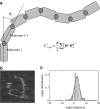In vitro reconstitution of the initial stages of the bacterial cell division machinery
- PMID: 19669505
- PMCID: PMC2577748
- DOI: 10.1007/s10867-008-9118-8
In vitro reconstitution of the initial stages of the bacterial cell division machinery
Abstract
Fission of many prokaryotes as well as some eukaryotic organelles depends on the self-assembly of the FtsZ protein into a membrane-associated ring structure early in the division process. Different components of the machinery are then sequentially recruited. Although the assembly order has been established, the molecular interactions and the understanding of the force-generating mechanism of this dividing machinery have remained elusive. It is desirable to develop simple reconstituted systems that attempt to reproduce, at least partially, some of the stages of the process. High-resolution studies of Escherichia coli FtsZ filaments' structure and dynamics on mica have allowed the identification of relevant interactions between filaments that suggest a mechanism by which the polymers could generate force on the membrane. Reconstituting the membrane-anchoring protein ZipA on E. coli lipid membrane on surfaces is now providing information on how the membrane attachment regulates FtsZ polymer dynamics and indicates the important role played by the lipid composition of the membrane.
Figures





Similar articles
-
Escherichia coli ZipA Organizes FtsZ Polymers into Dynamic Ring-Like Protofilament Structures.mBio. 2018 Jun 19;9(3):e01008-18. doi: 10.1128/mBio.01008-18. mBio. 2018. PMID: 29921670 Free PMC article.
-
Reconstitution of the Escherichia coli cell division ZipA-FtsZ complexes in nanodiscs as revealed by electron microscopy.J Struct Biol. 2012 Dec;180(3):531-8. doi: 10.1016/j.jsb.2012.08.013. Epub 2012 Sep 19. J Struct Biol. 2012. PMID: 23000704
-
FtsZ polymers bound to lipid bilayers through ZipA form dynamic two dimensional networks.Biochim Biophys Acta. 2012 Mar;1818(3):806-13. doi: 10.1016/j.bbamem.2011.12.012. Epub 2011 Dec 16. Biochim Biophys Acta. 2012. PMID: 22198391
-
Form and function of the bacterial cytokinetic ring.Curr Opin Cell Biol. 2014 Feb;26:19-27. doi: 10.1016/j.ceb.2013.08.006. Epub 2013 Sep 25. Curr Opin Cell Biol. 2014. PMID: 24529242 Review.
-
Macromolecular interactions of the bacterial division FtsZ protein: from quantitative biochemistry and crowding to reconstructing minimal divisomes in the test tube.Biophys Rev. 2013 Jun;5(2):63-77. doi: 10.1007/s12551-013-0115-1. Epub 2013 Apr 16. Biophys Rev. 2013. PMID: 28510160 Free PMC article. Review.
Cited by
-
Identification of Escherichia coli ZapC (YcbW) as a component of the division apparatus that binds and bundles FtsZ polymers.J Bacteriol. 2011 Mar;193(6):1393-404. doi: 10.1128/JB.01245-10. Epub 2011 Jan 7. J Bacteriol. 2011. PMID: 21216997 Free PMC article.
-
Physics of bacterial morphogenesis.Microbiol Mol Biol Rev. 2011 Dec;75(4):543-65. doi: 10.1128/MMBR.00006-11. Microbiol Mol Biol Rev. 2011. PMID: 22126993 Free PMC article. Review.
-
Simple modeling of FtsZ polymers on flat and curved surfaces: correlation with experimental in vitro observations.PMC Biophys. 2009 Oct 22;2(1):8. doi: 10.1186/1757-5036-2-8. PMC Biophys. 2009. PMID: 19849848 Free PMC article.
References
-
- {'text': '', 'ref_index': 1, 'ids': [{'type': 'DOI', 'value': '10.1016/S0074-7696(06)53002-5', 'is_inner': False, 'url': 'https://doi.org/10.1016/s0074-7696(06)53002-5'}, {'type': 'PubMed', 'value': '17098054', 'is_inner': True, 'url': 'https://pubmed.ncbi.nlm.nih.gov/17098054/'}]}
- Harry, E., Monahan, L., Thompson, L.: Bacterial cell division: the mechanism and its precision. Int. Rev. Cytol. 253, 27–93 (2006). doi:10.1016/S0074-7696(06)53002-5 - PubMed
-
- {'text': '', 'ref_index': 1, 'ids': [{'type': 'DOI', 'value': '10.1111/j.1365-2958.2006.05233.x', 'is_inner': False, 'url': 'https://doi.org/10.1111/j.1365-2958.2006.05233.x'}, {'type': 'PubMed', 'value': '16824090', 'is_inner': True, 'url': 'https://pubmed.ncbi.nlm.nih.gov/16824090/'}]}
- Vicente, M., Rico, A.I.: The order of the ring: assembly of Escherichia coli cell division components. Mol. Microbiol. 61(1), 5–8 (2006) - PubMed
-
- {'text': '', 'ref_index': 1, 'ids': [{'type': 'DOI', 'value': '10.1126/science.1059758', 'is_inner': False, 'url': 'https://doi.org/10.1126/science.1059758'}, {'type': 'PubMed', 'value': '11349149', 'is_inner': True, 'url': 'https://pubmed.ncbi.nlm.nih.gov/11349149/'}]}
- Surrey, T., Nédélec, F., Leibler, S., Karsenti, E.: Physical properties determining self-organization of motors and microtubules. Science 292(5519), 1167–1171 (2001). doi:10.1126/science.1059758 - PubMed
-
- {'text': '', 'ref_index': 1, 'ids': [{'type': 'DOI', 'value': '10.1038/ncb1498', 'is_inner': False, 'url': 'https://doi.org/10.1038/ncb1498'}, {'type': 'PubMed', 'value': '17060901', 'is_inner': True, 'url': 'https://pubmed.ncbi.nlm.nih.gov/17060901/'}]}
- Karsenti, E., Nédélec, F., Surrey, T.: Modelling microtubule patterns. Nat. Cell Biol. 8(11), 1204–1211 (2006). doi:10.1038/ncb1498 - PubMed
-
- {'text': '', 'ref_index': 1, 'ids': [{'type': 'DOI', 'value': '10.1073/pnas.0406598101', 'is_inner': False, 'url': 'https://doi.org/10.1073/pnas.0406598101'}, {'type': 'PMC', 'value': 'PMC535380', 'is_inner': False, 'url': 'https://pmc.ncbi.nlm.nih.gov/articles/PMC535380/'}, {'type': 'PubMed', 'value': '15569933', 'is_inner': True, 'url': 'https://pubmed.ncbi.nlm.nih.gov/15569933/'}]}
- Leduc, C., Campas, O., Zeldovich, K.B., Roux, A., Jolimaitre, P., Bourel-Bonnet, L., Goud, B., Joanny, J.F., Bassereau, P., Prost, J.: Cooperative extraction of membrane nanotubes by molecular motors. Proc. Natl. Acad. Sci. U. S. A. 101(49), 17096–17101 (2004). doi:10.1073/pnas.0406598101 - PMC - PubMed
LinkOut - more resources
Full Text Sources
Molecular Biology Databases

